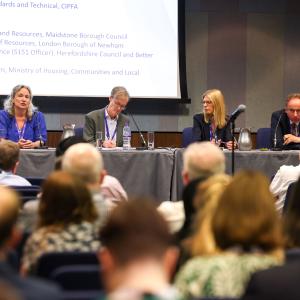By Vivienne Russell
22 October 2009
Barbara Young says she is a hands-on sort of inspector. The chair of the Care Quality Commission does not confine herself to the boardroom but likes to get out and about in the health service.
At the launch of the NHS’s performance ratings last week, she told assembled journalists, with some relish, how a chief executive’s face would fall when they came down to reception to greet the woman from the CQC for a routine hygiene check and found the chair standing there.
As Young and her chief executive Cynthia Bower were at pains to explain, this more direct, hands-on approach is going to characterise the CQC as it begins to test its powers and a very different kind of regulation will take its place. Out will go the annual snapshot of NHS performance, in will come an ongoing dialogue on performance and fitness to practise.
The performance ratings published last week were the first to emerge under the CQC banner but probably the last set of performance ratings to take quite this form, Young says.
The picture was broadly positive: more NHS trusts – including primary care, mental health and ambulance trusts – than ever before are now rated ‘excellent’ or ‘good’; there was a strong showing on financial management (as reported in last week’s Public Finance); primary care trusts are improving steadily; waiting times are down; and superbug infection rates have been slashed.
But there were concerns. Fewer acute and specialist hospital trusts earned themselves an ‘excellent’ rating. The reasons behind this were complex and included trusts’ failure to meet nationally set core standards – 59% were compliant as opposed to 69% last year – and areas of ongoing poor performance such as delayed transfers of care, cancelled operations and low breast-feeding rates.
The commission also said it had ‘deliberately taken steps to look in more detail at things that really matter to patients’, particularly hospital cleanliness and – in the wake of the Baby Peter scandal – child protection measures. In these areas, some parts of the NHS have been found wanting.
The CQC has also focused on the issue of persistent under-performance. Too many trusts are trundling along towards the bottom of the league table, Bower said.
This is an issue that exercises patient representatives. Katherine Murphy, director of the Patients Association, questions the point of a ratings system that allows such below-par performance to persist.
‘Surely the whole point [of an inspection system] is to say “you’re a poor performer, you need to improve”. And yes, some trusts have improved, but some very poor performers are still very poor performers. It really does question the effectiveness of the whole regulatory system,’ Murphy tells PF.
This is not the CQC’s fault, she adds. ‘They’re not there to performance manage the NHS, it’s actually the strategic health authorities and the primary care trusts. What are they doing if they’re not improving performance management in these areas?’
Add the problems of under-performance together with the licensing system the CQC will bring in next April and some very serious questions are raised about whether some trusts will earn a licence to operate come next spring.
Do those trusts that manage only a ‘weak’ or just a ‘fair’ judgement risk not making the grade?
Here the CQC dials down the rhetoric a notch. To say trusts are ‘not fit for purpose would be a harsh judgement’, says Bower. ‘What we’re saying is the guarantees aren’t in place.’
Frances Blunden, senior policy manager at the NHS Confederation, says that providers that do not meet all the registration standards could still be registered.
‘Last year, when registration came in for healthcare-acquired infections, there were some trusts that were registered with conditions attached to their registration, and in some cases it might have been quite a limited condition that they have been able to address over the year.’
Registration will focus minds quite sharply on what they need to do to demonstrate that they are compliant, Blunden adds.
The NHS Confederation welcomes the move away from the process-driven approach that characterised the outgoing annual health evaluation. The previous system checked whether a trust had a particular policy but not whether the policy was being implemented and the effect on patients. The new one will be predicated on outcomes.
But Blunden warns: ‘It’s much harder to do and will require a different approach to thinking.
‘Some trusts are doing really well at getting themselves prepared for that, others are less advanced.’
She also raises concerns about the practicality of ensuring all trusts are compliant with standards 24 hours a day, 365 days a year.
The Patients Association has similar worries. The annual health check is focused on standards and safeguards and policies and is not an absolute verification about the quality of care, Murphy says.
‘But what [the CQC is] trying to say is that the registration process will be about saying this trust provides that standard of care, 24 hours day. I really struggle to understand how they are going to do that.
‘[Trusts] can’t even do this, which is just a once-a-year sign-off. How do they think they are going to manage 24-hour rolling enforcement? We’re very sceptical.’
A lot of ‘weak’ and ‘fair’ trusts won’t be able to successfully register, Murphy predicts. ‘Again, what are they going to do in the next six months that will make all those trusts that haven’t been able to improve in the past four years suddenly come up to scratch?’
The answer, says the CQC, is to work actively with trusts on identifying and solving problem issues. The NHS is becoming increasingly better at self-diagnosis and the CQC’s verdict in last week’s performance ratings should not have come as a surprise.
There is an ‘ongoing process of debate with organisations’, Bower says.
‘If there are things now that we are concerned about, we’re talking to trusts. We’re not waiting until April 1 [next year] to say who has got to the mark and who hasn’t.’
Non-registration of trusts would be ‘an extreme nuclear option’, she adds.
‘We’re obliged by law to operate in a proportionate way. There’s a range of responses we can make.’
Young has the final word. ‘We’re going to be very insistent. We’re going to do the diagnostics on why [trusts] are failing.’
Bad management is not always the problem, some trusts might just be configured wrongly.
‘Good inspection is not punishing people because they’re under-performing, but helping them to improve.’
22 October 2009
Barbara Young says she is a hands-on sort of inspector. The chair of the Care Quality Commission does not confine herself to the boardroom but likes to get out and about in the health service.
At the launch of the NHS’s performance ratings last week, she told assembled journalists, with some relish, how a chief executive’s face would fall when they came down to reception to greet the woman from the CQC for a routine hygiene check and found the chair standing there.
As Young and her chief executive Cynthia Bower were at pains to explain, this more direct, hands-on approach is going to characterise the CQC as it begins to test its powers and a very different kind of regulation will take its place. Out will go the annual snapshot of NHS performance, in will come an ongoing dialogue on performance and fitness to practise.
The performance ratings published last week were the first to emerge under the CQC banner but probably the last set of performance ratings to take quite this form, Young says.
The picture was broadly positive: more NHS trusts – including primary care, mental health and ambulance trusts – than ever before are now rated ‘excellent’ or ‘good’; there was a strong showing on financial management (as reported in last week’s Public Finance); primary care trusts are improving steadily; waiting times are down; and superbug infection rates have been slashed.
But there were concerns. Fewer acute and specialist hospital trusts earned themselves an ‘excellent’ rating. The reasons behind this were complex and included trusts’ failure to meet nationally set core standards – 59% were compliant as opposed to 69% last year – and areas of ongoing poor performance such as delayed transfers of care, cancelled operations and low breast-feeding rates.
The commission also said it had ‘deliberately taken steps to look in more detail at things that really matter to patients’, particularly hospital cleanliness and – in the wake of the Baby Peter scandal – child protection measures. In these areas, some parts of the NHS have been found wanting.
The CQC has also focused on the issue of persistent under-performance. Too many trusts are trundling along towards the bottom of the league table, Bower said.
This is an issue that exercises patient representatives. Katherine Murphy, director of the Patients Association, questions the point of a ratings system that allows such below-par performance to persist.
‘Surely the whole point [of an inspection system] is to say “you’re a poor performer, you need to improve”. And yes, some trusts have improved, but some very poor performers are still very poor performers. It really does question the effectiveness of the whole regulatory system,’ Murphy tells PF.
This is not the CQC’s fault, she adds. ‘They’re not there to performance manage the NHS, it’s actually the strategic health authorities and the primary care trusts. What are they doing if they’re not improving performance management in these areas?’
Add the problems of under-performance together with the licensing system the CQC will bring in next April and some very serious questions are raised about whether some trusts will earn a licence to operate come next spring.
Do those trusts that manage only a ‘weak’ or just a ‘fair’ judgement risk not making the grade?
Here the CQC dials down the rhetoric a notch. To say trusts are ‘not fit for purpose would be a harsh judgement’, says Bower. ‘What we’re saying is the guarantees aren’t in place.’
Frances Blunden, senior policy manager at the NHS Confederation, says that providers that do not meet all the registration standards could still be registered.
‘Last year, when registration came in for healthcare-acquired infections, there were some trusts that were registered with conditions attached to their registration, and in some cases it might have been quite a limited condition that they have been able to address over the year.’
Registration will focus minds quite sharply on what they need to do to demonstrate that they are compliant, Blunden adds.
The NHS Confederation welcomes the move away from the process-driven approach that characterised the outgoing annual health evaluation. The previous system checked whether a trust had a particular policy but not whether the policy was being implemented and the effect on patients. The new one will be predicated on outcomes.
But Blunden warns: ‘It’s much harder to do and will require a different approach to thinking.
‘Some trusts are doing really well at getting themselves prepared for that, others are less advanced.’
She also raises concerns about the practicality of ensuring all trusts are compliant with standards 24 hours a day, 365 days a year.
The Patients Association has similar worries. The annual health check is focused on standards and safeguards and policies and is not an absolute verification about the quality of care, Murphy says.
‘But what [the CQC is] trying to say is that the registration process will be about saying this trust provides that standard of care, 24 hours day. I really struggle to understand how they are going to do that.
‘[Trusts] can’t even do this, which is just a once-a-year sign-off. How do they think they are going to manage 24-hour rolling enforcement? We’re very sceptical.’
A lot of ‘weak’ and ‘fair’ trusts won’t be able to successfully register, Murphy predicts. ‘Again, what are they going to do in the next six months that will make all those trusts that haven’t been able to improve in the past four years suddenly come up to scratch?’
The answer, says the CQC, is to work actively with trusts on identifying and solving problem issues. The NHS is becoming increasingly better at self-diagnosis and the CQC’s verdict in last week’s performance ratings should not have come as a surprise.
There is an ‘ongoing process of debate with organisations’, Bower says.
‘If there are things now that we are concerned about, we’re talking to trusts. We’re not waiting until April 1 [next year] to say who has got to the mark and who hasn’t.’
Non-registration of trusts would be ‘an extreme nuclear option’, she adds.
‘We’re obliged by law to operate in a proportionate way. There’s a range of responses we can make.’
Young has the final word. ‘We’re going to be very insistent. We’re going to do the diagnostics on why [trusts] are failing.’
Bad management is not always the problem, some trusts might just be configured wrongly.
‘Good inspection is not punishing people because they’re under-performing, but helping them to improve.’


















